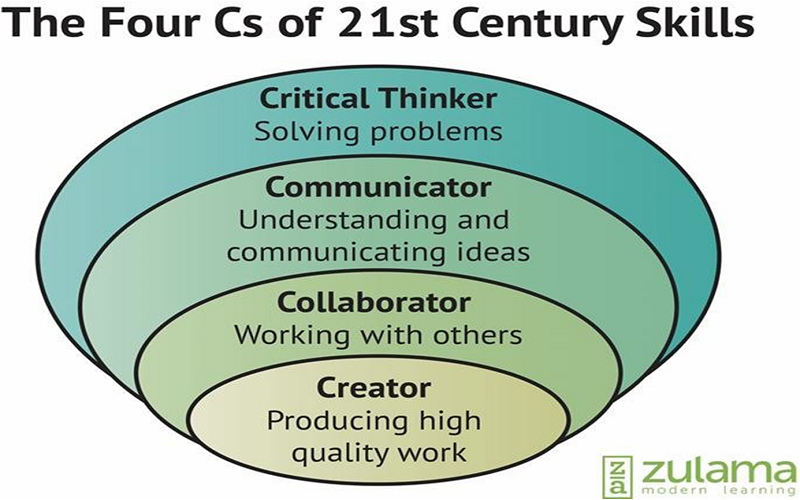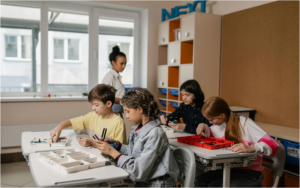Education in the twenty-first century is always changing, revealing new and effective teaching strategies. More than ever, the 4 C’s of 21st-century education are being acknowledged and used in the classroom to highlight the potential of our students. Would you want to learn how to properly train these skills and why it’s so important to have the 4Cs in your toolbox? Keep reading on to train your students to apply these 4 C’s in real-life situations.
What Are The 4 C’s Of Education?

Source: researchgate.net
Here are the four key elements of 21st-century education that every school must follow:
1. Critical Thinking
The capacity to objectively analyze, assess, and comprehend data is known as critical thinking. It pushes pupils to think critically, examine opposing viewpoints, and arrive at well-informed conclusions. Students who practice critical thinking become more knowledgeable people who can handle problems more effectively.
2. Creativity
Innovation and invention are propelled by creativity. It entails using creativity, investigating novel concepts, and taking a fresh approach to problems. By encouraging creativity, educators may help kids reach their greatest potential, find novel solutions, and develop a spirit of inquiry and discovery.
3. Collaboration
Collaboration highlights how important it is to collaborate well with others. Pupils get knowledge on how to respect different points of view, express themselves effectively, and work well in a group environment. Since complicated challenges frequently call for combined efforts and the pooling of knowledge, collaborative skills are becoming more and more important.
4. Communication
Successful relationships are fundamentally based on effective communication. This ability includes listening intently to others and conveying views. Effective communicators can express ideas clearly and sympathetically, which promotes collaboration and improved understanding.
Why Are The 4 C’s Essential?
Students who master all four Cs will be better equipped to handle the possibilities and problems that they will probably encounter in the future. These abilities may also be used far outside of the classroom, which can assist young people find better employment opportunities after graduation.
In real life, the 4 Cs will assist students in gaining important transferable abilities, such as:
-
- Problem-solving
- Public speaking
- Working in teams
- Embracing new concepts and ideas
- Active listening
How Can Educators Incorporate The 4 C’s In Their Teaching?
Here are a few ways you as educators can integrate the above-mentioned components into your daily teaching strategies:
Assign Tasks Based On Any Of The Skills
Curate activities and projects with a particular focus on cultivating one of the four Cs. By giving kids assignments that let them communicate their thoughts creatively. For example, by utilizing color, visuals, or creative writing to help them grasp the material, you can foster creativity in your pupils.
Additionally, this can be quite helpful for visual learners. You may try introducing group discussions or presentations where students can exchange ideas and collaborate to create their presentations as a way to foster teamwork and communication.
Encourage Students To Collaboration
Assign your pupils the responsibility of cooperating to accomplish a shared objective. Students get a great opportunity to practice cooperating and hone their cooperation skills via group projects and activities.
Students get an appreciation for different viewpoints, develop good communication skills, and use their abilities to achieve group goals by working together on projects. Students’ listening comprehension abilities are enhanced, the four Cs of education are fostered, and they get ready for the workplace of the future.
Make Learning Engaging
Provide engaging and interactive learning opportunities to pique students’ curiosity. Utilize technology, multimedia, and hands-on activities to add vibrancy and relevance to your lessons.
Encourage student involvement, critical thinking, and creativity by including them in conversations, debates, and problem-solving activities. Students are more likely to be motivated and have a better comprehension of the material when learning is made interesting and relevant for them.
Enhance Lessons With Technology
When attempting to assist pupils in developing their abilities, educational tools like interactive whiteboards might appear to be quite helpful.
Including technology in your classes also helps your pupils become more digitally literate, which is crucial in today’s technology-driven environment.
Embrace Various Learning Styles
To achieve their best academic potential, various pupils require different things from their professors. It’s important to recognize that every student is different and that what comes easy to one may be quite challenging for another.
Using materials based on the VARK learning styles model is the most effective approach to do this.
Reward Students For Efforts
When students exhibit the four Cs, it should be recognized and appreciated, whether it’s in scheduled classes, on field excursions, or in their projects for extended study. Teachers encourage students to keep improving their 4 Cs abilities by praising and acknowledging their application of these concepts in real-world situations.
Furthermore, cultivating a culture of respect for the four Cs promotes peer support and fosters a pleasant learning environment in the classroom, both of which help the growth of these crucial competencies.
Unlock Your Teaching Potential With The 4 C’s
Are you trying to think of creative methods to support the four Cs of education in your teaching? Use the above-mentioned information as a guide to learn everything about the 4 C’s and practice them interactively in your classroom. Additionally, you can also pursue an online Pre and Primary teacher training course in Indonesia to be aware of the various needs of the students and cater to them accordingly to help them achieve the learning objectives.



